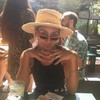Three Fa‘afafine (After Gauguin), 2020 by Yuki Kihara from Paradise Camp series. (Courtesy of Yuki Kihara and Milford Galleries)
(right) Two Fa'afafine (After Gauguin) by Yuki Kihara (2020). (Left) Two Tahitian Women by Paul Gauguin (1899)
Spirit of the ancestors watching (After Gauguin), 2020 Artwork by Yuki Kihara (Photo by Zan Wimberley)
Charles Kerry glass plates from the Powerhouse collection in Paradise Camp by Yuki Kihara (Photo by Zan Wimberley)
Fonofono o le nuanua: Patches of the rainbow (After Gauguin), 2020 Artwork by Yuki Kihara (Photo by Zan Wimberley)
“To look behind the Paradise or the images of paradise that overshadow the kind of environmental catastrophe that we're facing in the Pacific. And then why is it that in this climate change space or environmental space, Fa'afafine or LGBTQ+ people’s voices are neglected?”
Nafea e te fa‘aipoipo? When will you marry? (After Gauguin), 2020 by Yuki Kihara from Paradise Camp series. Courtesy of Yuki Kihara and Milford Galleries, Aotearoa New Zealand. .jpg
Genesis 9:16 (After Gauguin), 2020 by Yuki Kihara from Paradise Camp series (Courtesy of Yuki Kihara and Milford Galleries, Aotearoa New Zealand)
Two Fa‘afafine on the beach (After Gauguin), 2020 by Yuki Kihara from Paradise Camp series. (Courtesy of Yuki Kihara and Milford Galleries, Aotearoa New Zealand)
